Zur Ausstellung: problems
Saalblatt
von John Beeson
This afternoon, Pedro Wirz and I went to lunch together. Raphael Linsi, who had just eaten, decided to stay behind and work. Pedro and I walked down to Schlemmer Zentrum and each had a hamburger. Since he’s been so busy working with Reto, a member of the team at Kunstraum Kreuzlingen, to build up the display for his work, I took this opportunity to ask Pedro a some questions:
„(1) Would you,“ I asked, „please pick a number between four and seven?“
„Seven,“ he replied, without a moment’s hesitation.
„(2) How many sculptures are in the exhibition?“
„Eleven.“
„(3) How were they made?“
„Wood, rope, aluminum, lacquer – really bad paint – and fabric … and paper … and shadow, kind of.“
„(4) But how were they made?“
„They were a set of pieces put together under a set of rules.“
„(5) Who made them?“
„David Goodman made two, Florine Leoni made one, Thomas Jeppe made two, Wojciech Kosma made one, Bradley Alexander made one, Laura McLardy made one, Tina Kämpe made one, Anatoly Belov made one, and Sarah Elliott made one.“
„(6) And what stance does this work take in relation to the politics of display?“
„The whole display was conceived through the necessity that the sculptures had. But since I was dealing with a toy, I decided to develop a display which should work as a kind of playground.“
„(7) In your opinion, what’s the most important part of friendship?“
Earnestly, he responded, „I don’t know how to answer this question. But I would say: ‚the essence‘.“
Later in the afternoon, upon our return to the exhibition space, Pedro and I picked up Raphael, and we all walked down to Lake Constance together in search of ice cream. Raphael decided that we should go to Martin’s, a soft serve stand, since it had the nicest sign and because last week he had seen a lot of retired people queuing there. Pedro got a waffle cone with chocolate and pistachio. I got chocolate and strawberry. And Raphael got strawberry and pistachio.
Sitting by the lake, Raphael and I talked about the way that things had gone with his and Pedro’s exhibition. The conversation progressed slowly, but our desire to have a meaningful exchange pushed us forward – the sun falling warmly on our backs, the wind steadily blowing and the waves crashing in, as if our presence and our intention was reflected in the natural world around us. The silences in Raphael’s and my conversation left me with a lot of time to think about what I know about him and his work. He takes his time doing things; that’s something I know about him. And he is particular about details. He once told me that when he has to install his work he likes to put a painting in one place and then spend a few hours thinking about that choice. It’s as if he’s after some sense of divine perfection, be it the placement of a painting on a wall or the placement of a brushstroke on a painting. But, at some point, Raphael makes the choices that he needs to in order for the work to find itself in the presence of viewers; in all faiths there comes a point when one is forced to come to terms with one’s inability to achieve perfection, to accept that. We were admittedly distracted by Pedro, who had been orbiting around us while talking with a group of swimmers. He took a long dip in the water, then he laid out in the sun on the rocky beach in front of us. We thought this was as good a time as any to get back to the space so that the guys could put the finishing touches on the show.
When I asked Raphael if he liked his ice cream, he answered, „Yes.“
Afterwards, he came back and whispered, „But I think the strawberry tasted better than the pistachio.“
